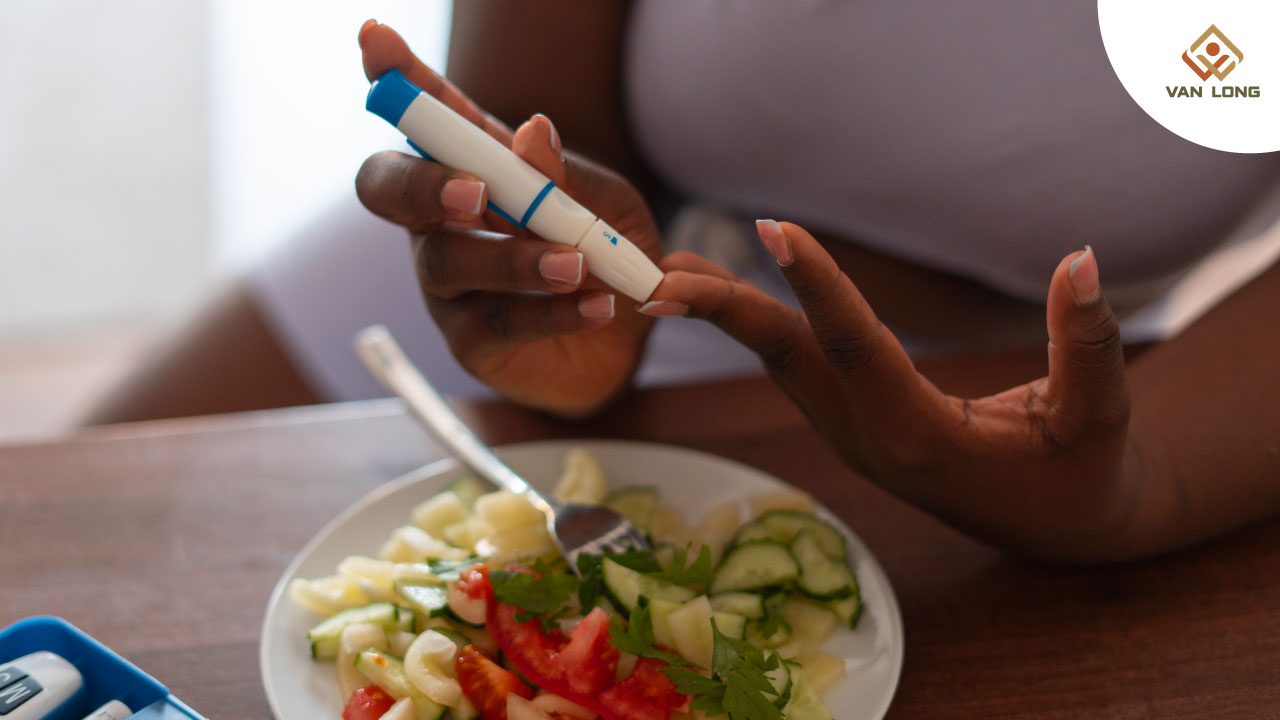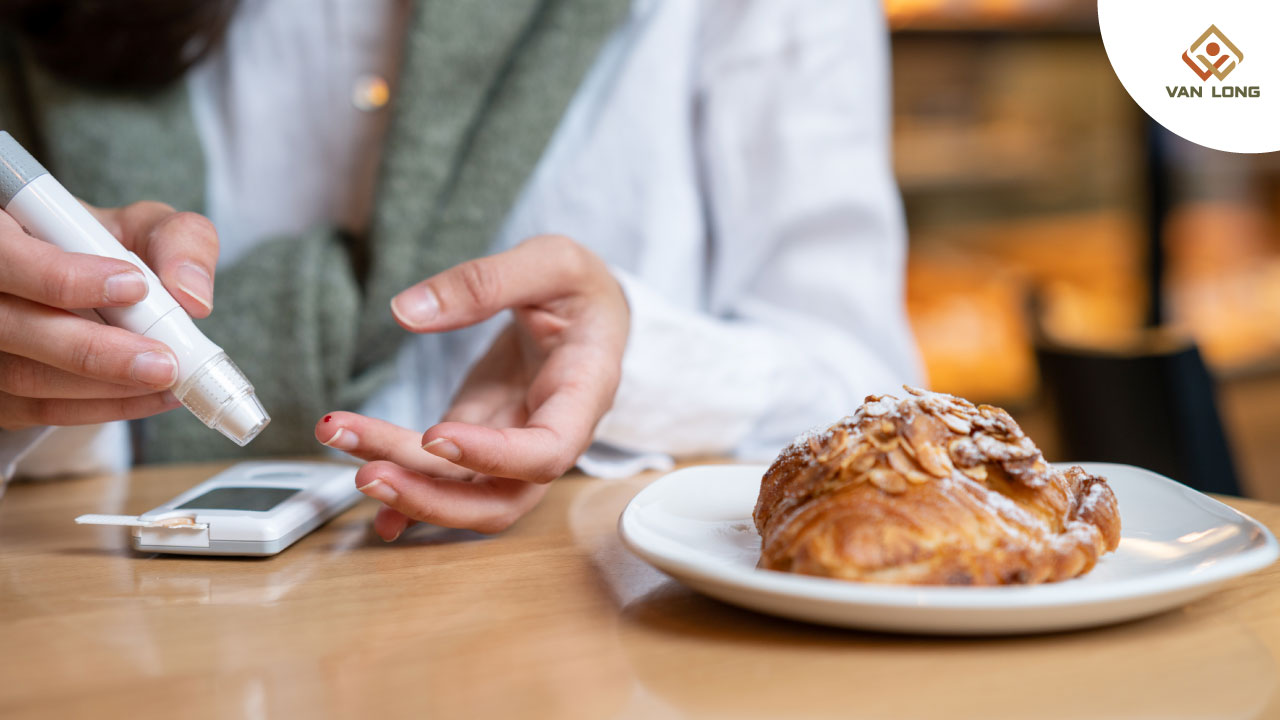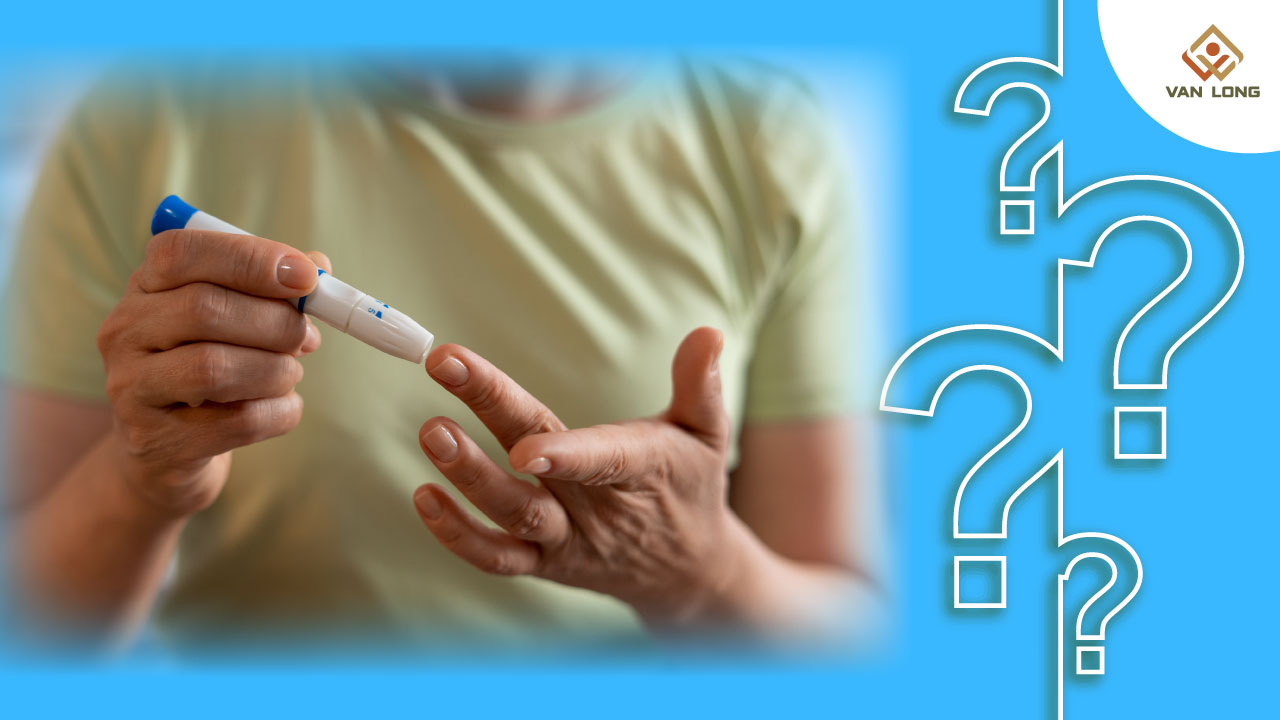Nếu bạn đã quen đo đường huyết lúc đói thì cũng đừng bỏ qua chỉ số sau ăn – một yếu tố quan trọng để đánh giá khả năng kiểm soát đường trong máu của cơ thể. Theo nhiều nghiên cứu, đường huyết tăng quá cao sau bữa ăn chính là “thủ phạm thầm lặng” làm tăng nguy cơ biến chứng tim mạch, suy thận và tổn thương thần kinh ở người tiểu đường.
1. Đo đường huyết sau ăn: Có quan trọng như đo khi đói?

Nhiều người thường chỉ đo lúc đói, nghĩ rằng như vậy là đủ. Nhưng thực tế, chỉ số sau ăn phản ánh cách cơ thể “xử lý” lượng glucose từ thức ăn. Người khỏe mạnh có hệ insulin hoạt động tốt, giúp đường huyết trở về mức an toàn sau 1–2 giờ. Nhưng người tiền tiểu đường hoặc tiểu đường type 2 thường bị rối loạn chức năng này — đường huyết sau ăn sẽ cao hơn và kéo dài lâu hơn.
Theo Hiệp hội Đái tháo đường Hoa Kỳ (ADA), kiểm soát đường huyết sau ăn tốt giúp:
- Giảm nguy cơ biến chứng mạch máu nhỏ (võng mạc, thận)
- Giảm gánh nặng cho tụy, hạn chế phải tăng liều thuốc
- Đánh giá hiệu quả điều chỉnh chế độ ăn uống, tập luyện
Lưu ý: Đo sau ăn quan trọng không kém đo khi đói, đặc biệt nếu bạn muốn theo dõi chỉ số đường huyết toàn diện.
2. Đường huyết sau ăn bao nhiêu là bình thường?
Các chuyên gia thường chia mức tham khảo ra sau ăn 1 giờ và sau ăn 2 giờ, để dễ so sánh.
2.1 Sau ăn 1 giờ:
-
Người khỏe mạnh: thường dưới 140–160 mg/dL
-
Tiền tiểu đường: 160–180 mg/dL
-
Tiểu đường: có thể trên 180 mg/dL nếu chưa kiểm soát tốt
2.2 Sau ăn 2 giờ:
-
Người khỏe mạnh: < 140 mg/dL
-
Tiền tiểu đường: 140–199 mg/dL
-
Tiểu đường: ≥ 200 mg/dL (nếu kèm triệu chứng như khát nhiều, tiểu nhiều, sút cân)
Những ngưỡng này giúp bạn dễ dàng đối chiếu các kết quả đo tại nhà. Nếu thường xuyên đo vượt ngưỡng an toàn, bạn cần xem lại khẩu phần ăn, vận động hoặc tái khám để điều chỉnh thuốc.
3. So sánh chỉ số sau ăn: Người khỏe mạnh và Người tiểu đường

Hãy hình dung bữa ăn như một “bài test” cho cơ chế điều tiết insulin. Ở người khỏe mạnh, đường huyết thường tăng ngay sau ăn khoảng 30 phút – 1 giờ, rồi dần trở về mức bình thường sau 2 giờ. Nếu cơ thể vẫn duy trì mức cao bất thường, nghĩa là tuyến tụy không tiết đủ insulin hoặc tế bào kháng insulin.
3.1 Người khỏe mạnh:
- Đường huyết dao động trong biên độ hẹp, ít khi vượt quá 140 mg/dL sau 2 giờ.
- Hệ mạch máu ít bị tổn thương.
3.2 Người tiền tiểu đường:
- Chỉ số sau ăn thường cao hơn mức bình thường, nhưng chưa vượt ngưỡng chẩn đoán tiểu đường.
- Nguy cơ tiến triển thành tiểu đường type 2 trong 5–10 năm nếu không thay đổi lối sống.
3.3 Người tiểu đường:
- Đường huyết có thể tăng đột biến sau ăn, kéo dài hơn 2 giờ.
- Cần theo dõi sát sao để điều chỉnh thuốc hoặc insulin kịp thời.
4. Nếu đường huyết sau ăn cao thì nên làm gì?
Phát hiện đường huyết sau ăn cao không có nghĩa là đã quá muộn. Điều quan trọng là phải hành động ngay để ngăn ngừa biến chứng:
4.1 Điều chỉnh bữa ăn:
- Giảm tinh bột xấu (cơm trắng, bánh ngọt)
- Ăn nhiều rau xanh, chất xơ để làm chậm hấp thu đường
- Chia nhỏ bữa thay vì ăn quá nhiều trong một lần
4.2 Tăng cường vận động:
- Đi bộ nhẹ sau bữa ăn 15–30 phút
- Tập các bài tập vừa sức, không ngồi một chỗ ngay sau ăn
4.3 Theo dõi thường xuyên:
- Dùng máy đo đường huyết để ghi chép chỉ số trước và sau ăn, giúp phát hiện xu hướng tăng giảm.
4.4 Tham khảo bác sĩ:
- Nếu chỉ số sau ăn thường xuyên trên 200 mg/dL, bạn nên hỏi ý kiến bác sĩ để điều chỉnh phác đồ điều trị.
5. Hướng dẫn đo đường huyết sau ăn tại nhà bằng máy đo đường huyết

Để kết quả chính xác, bạn cần tuân thủ các bước chuẩn sau:
5.1 Chuẩn bị đúng
- Rửa tay sạch, lau khô hoàn toàn
- Không dùng tay dính cồn sát khuẩn khi chích máu
- Dùng kim lấy máu mới, que thử còn hạn sử dụng
5.2 Chọn thời điểm đo
- Sau ăn 1 giờ: Phản ánh mức đỉnh đường huyết
- Sau ăn 2 giờ: Phản ánh khả năng trở về mức an toàn
Một số chuyên gia khuyên nên đo cả hai để thấy rõ mức tăng giảm.
5.3 Ghi chép & lưu trữ
6. Kinh nghiệm chọn máy đo đường huyết phù hợp
Đừng để máy đo sai lệch làm bạn hoang mang. Hãy ưu tiên thiết bị đạt chuẩn quốc tế (ISO 15197:2013), sai số thấp dưới 15%, có khả năng phân biệt đo lúc đói/sau ăn. Máy đo đường huyết Yuwell 582 được thiết kế chuyên biệt với các tính năng:
- Lưu trữ nhiều kết quả, dễ tra cứu
- Hiển thị chỉ số rõ ràng
- Cảnh báo khi vượt ngưỡng an toàn
- Dễ thao tác cho cả người lớn tuổi
7. Câu hỏi thường gặp (FAQ)

- Có nên đo đường huyết sau ăn mỗi ngày?
- Không bắt buộc, nhưng nên đo ít nhất 2–3 lần/tuần để kiểm soát xu hướng.
- Khi nào đo đường huyết sau ăn 1 giờ, khi nào đo 2 giờ?
- Sau ăn 1 giờ cho thấy mức đỉnh. Sau ăn 2 giờ cho thấy tốc độ “giải phóng” glucose về mức an toàn.
- Chỉ số sau ăn luôn cao, dù ăn ít. Có nguy hiểm không?
- Có thể bạn đang ở giai đoạn tiền tiểu đường hoặc tiểu đường type 2. Hãy đến cơ sở y tế để kiểm tra HbA1c và hỏi bác sĩ.
8. Đo chỉ số sau ăn – Bí quyết kiểm soát tiểu đường chủ động
Đường huyết sau ăn cao là lời nhắc nhở cơ thể bạn đang gặp vấn đề chuyển hóa. Biến việc sử dụng máy đo đường huyết thành thói quen khoa học sẽ giúp bạn kịp thời điều chỉnh ăn uống, luyện tập và phối hợp điều trị. Chìa khóa thành công là kiểm soát đường huyết trước ăn & sau ăn mới thực sự toàn diện.
——————————
CÔNG TY TNHH PHÁT TRIỂN THƯƠNG MẠI DỊCH VỤ VÂN LONG
YOUR NEEDS - OUR BUSINESS
- Hotline: (028) 3526 2468 / 098.484.0440
- Email: cskh@vl-groups.com
- Website: www.vl-groups.com
- Địa chỉ:
- Văn phòng HCM: Tòa nhà Fosco, D35 + D36 - 40 Bà Huyện Thanh Quan, P.Võ Thị Sáu, Q.3, TP. HCM
- Trung tâm bảo hành: 373/14 Nguyễn Kiệm, P.9, Q.Phú Nhuận, TP.HCM
- Văn phòng Hà Nội: Khu VP Hồng Hà, 38.3/1 Ngõ 109 Trường Chinh, P.Phương Liệt, Q.Thanh Xuân, Hà Nội
- Kho Tổng: 938 Quốc Lộ 1A, Phường Linh Trung, TP Thủ Đức, TP.HCM
🌼 Shopee: https://shopee.vn/vanlonggroups
🌼 Tiktok: https://www.tiktok.com/@thietbichamsocsuckhoe
🌼 Tiki: https://tiki.vn/cua-hang/cham-soc-suc-khoe-van-long
🌼 Lazada: https://www.lazada.vn/shop/van-long-our-needs-your-business



